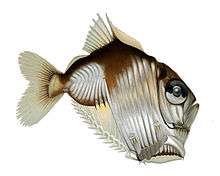Sternoptyx diaphana
Sternoptyx diaphana, the diaphanous hatchetfish, is a species of deep sea ray-finned fish in the family Sternoptychidae. It is the type species of the genus Sternoptyx, and was first described by the French naturalist Johann Hermann in Der Naturforscher 1781.[3]
| Sternoptyx diaphana | |
|---|---|
 | |
| Diaphanous hatchetfish | |
| Scientific classification | |
| Domain: | |
| Kingdom: | |
| Phylum: | |
| Class: | |
| Order: | |
| Family: | |
| Subfamily: | |
| Genus: | |
| Species: | Sternoptyx diaphana |
| Binomial name | |
| Sternoptyx diaphana | |
Description
Sternoptyx diaphana is a short, deep-bodied fish with a laterally compressed body and a maximum length of about 45 mm (1.8 in). The mouth is nearly vertical, the snout is short and the eyes are large. The body slopes steeply up from the head and levels off at the caudal peduncle. In front of the dorsal fin is a toothed, pear-shaped translucent plate supported by a single spine. The dorsal fin has 9 to 12 soft rays and the anal fin 13 to 14. There is a translucent fold of skin just below the short tail, and another below the ventral region of the body. There are photophores behind and below the eye, on the gill cover, and rows of photophores on the underside of the fish. The dorsal region is dark, the flanks are silvery and the fins transparent.[4][5]
Distribution and habitat
S. diaphana has a wide distribution in temperate and tropical waters of all the world's oceans, although occurring with less frequency in equatorial seas. Its depth range is 300 and 1,500 metres (1,000 and 5,000 ft), but it is most often found between about 600 and 900 metres (2,000 and 3,000 ft), where the water temperature is between 4 to 11 °C (39 to 52 °F). It appears not to make the daily vertical migrations made by some related species.[6]
Ecology
The diet consists of small fish, euphausiids, decapods, copepods and amphipods. Larger fish generally consume larger food items; the diet varies with location with the fish appearing to be opportunistic predators of whatever prey species they encounter.[6]
Status
S. diaphana has a very wide distribution, is a common species and faces no particular threats. For these reasons, the International Union for Conservation of Nature has assessed its conservation status as being of "least concern".[1]
References
- Harold, A. (2015). "Sternoptyx diaphana". IUCN Red List of Threatened Species. 2015: e.T18253296A21913860. doi:10.2305/IUCN.UK.2015-4.RLTS.T18253296A21913860.en.
- Bailly, Nicolas (2015). "Sternoptyx diaphana Hermann, 1781". WoRMS. World Register of Marine Species. Retrieved 27 February 2016.
- Hermann, J. 1781. Schreiben an den Herausgeber über ein neues amerikanisches Fischgeschlecht, Sternoptyx diaphana, der durchsichtige Brust-Falten-Fisch. - Der Naturforscher 16: 8-36, Tab. I [= 1]. Halle.
- The Fishes of the Indo-Australian Archipelago. Brill Archive. pp. 132–133. GGKEY:6JSRCF1TTR1.
- McEachran, John; Fechhelm, Janice D. (2013). Fishes of the Gulf of Mexico, Vol. 1: Myxiniformes to Gasterosteiformes. University of Texas Press. p. 437. ISBN 978-0-292-75705-9.
- Hopkins, T.L.; Baird, R.C. (1973). "Diet of the hatchetfish Sternoptyx diaphana". Marine Biology. 21 (1): 34–46. doi:10.1007/BF00351190.
